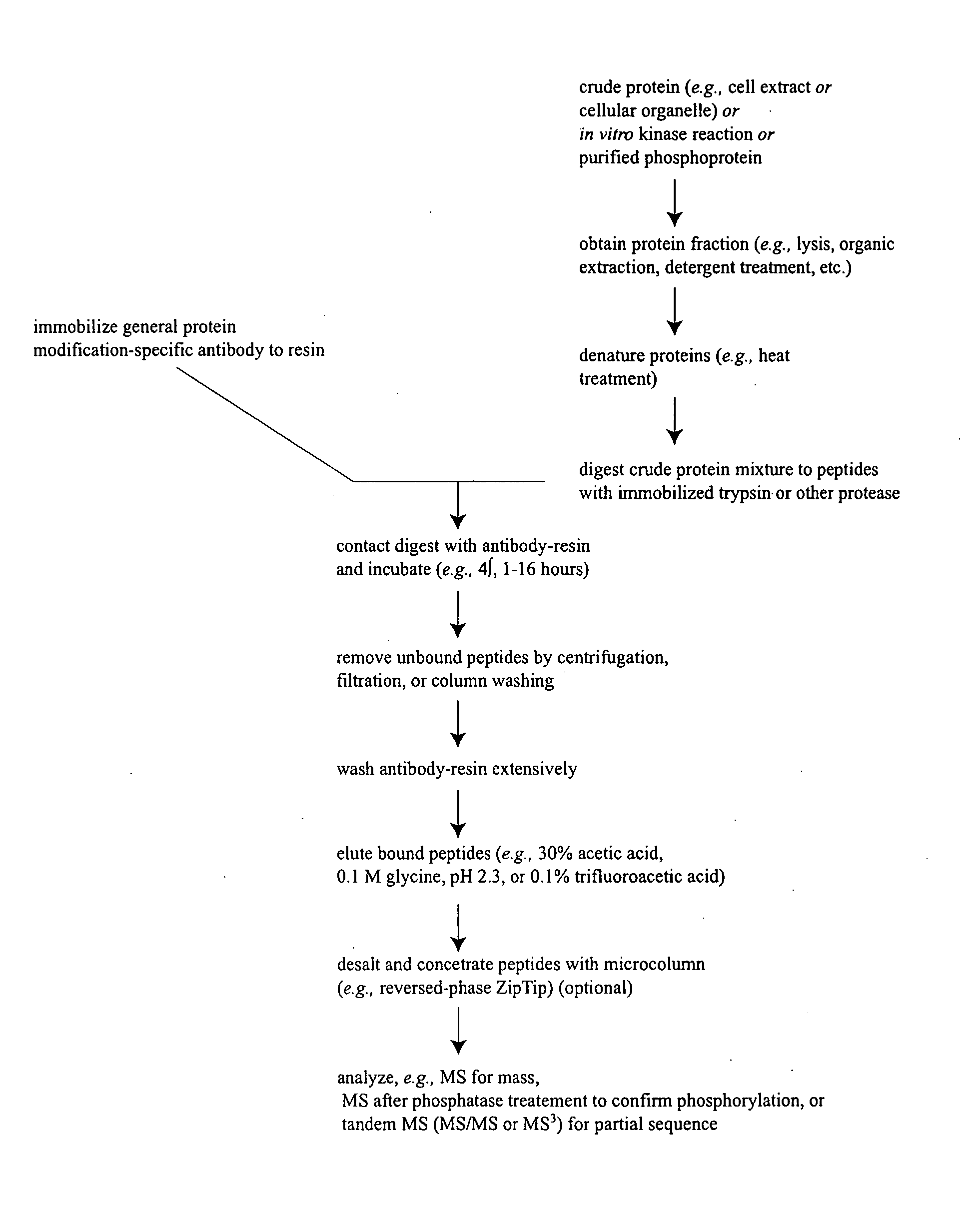Reagents for the detection of protein phosphorylation in anaplastic large cell lymphoma signaling pathways
a technology of anaplastic large cell lymphoma and signaling pathways, which is applied in the field of antibodies and peptide reagents for the detection of protein phosphorylation and to protein phosphorylation in cancer, can solve the problems of unfavorable development of the technology necessary to unravel and the complexity of the cellular modification system is extraordinarily complex
- Summary
- Abstract
- Description
- Claims
- Application Information
AI Technical Summary
Problems solved by technology
Method used
Image
Examples
example 1
Isolation of Phosphotyrosine-Containing Peptides from Extracts of Karpas-299 and SUDHL-1 Cells and Identification of Novel Phosphorylation Sites
[0144] In order to discover previously unknown ALCL-related signal transduction protein phosphorylation sites, IAP isolation techniques were employed to identify phosphotyrosine containing peptides in cell extracts from Karpas 299 and SU-DHL-1 cells, which are derived from anaplastic large cell lymphomas (ALCL). See Pulford et al. Blood 89: 394-1404 (1997). The majority of ALCL is characterized by the presence of the t(2; 5)(p23; q35) chromosomal translocation that causes the fusion of the nucleophosmin and anaplastic lymphoma kinase genes. See Morris S W, Science 263: 1281-1284 (1994). Although the two cell lines are derived from different patients, both express the oncogenic fusion kinase NPM-ALK, which possesses constitutive tyrosine kinase activity and can transform non-malignant cells. See Fujimoto, supra.
[0145] Tryptic phosphotyrosin...
example 2
Production of Phospho-specific Polyclonal Antibodies for the Detection of ALCL-Related Protein Phosphorylation
[0155] Polyclonal antibodies that specifically bind an ALCL-related signal transduction protein only when phosphorylated at the respective phosphorylation site disclosed herein (see Table 1) are produced according to standard methods by first constructing a synthetic peptide antigen comprising the phosphorylation site sequence and then immunizing an animal to raise antibodies against the antigen, as further described below. Production of exemplary polyclonal antibodies is provided below.
A. ALK (Tyrosine 1282).
[0156] A 15 amino acid phospho-peptide antigen, RDIYRASy*YRKGGCA (SEQ ID NO: 142) (where y*=phosphotyrosine), that corresponds to the tyrosine 1282 phosphorylation site in human anaplastic lymphoma kinase (ALK) (see Row 143 of Table 1), plus cysteine on the C-terminal for coupling, is constructed according to standard synthesis techniques using, e.g., a Rainin / Prote...
example 3
Production of Phospho-Specific Monoclonal Antibodies for the Detection of ALCL-Related Protein Phosphorylation
[0163] Monoclonal antibodies that specifically bind an ALCL-related signal transduction protein only when phosphorylated at the respective phosphorylation site disclosed herein (see Table 1) are produced according to standard methods by first constructing a synthetic peptide antigen comprising the phosphorylation site sequence and then immunizing an animal to raise antibodies against the antigen, and harvesting spleen cells from such animals to produce fusion hybridomas, as further described below. Production of exemplary monoclonal antibodies is provided below.
A. ALK (Tyrosine 1078).
[0164] A 15 amino acid phospho-peptide antigen, MELQSPEy*KLSKLRT (SEQ ID NO: 138) (where y*=phosphotyrosine) that corresponds to the tyrosine 1078 phosphorylation site in human Anaplastic Lymphoma Kinase (ALK) (see Row 139 of Table 1), plus cysteine on the C-terminal for coupling, is constru...
PUM
| Property | Measurement | Unit |
|---|---|---|
| concentration | aaaaa | aaaaa |
| pH | aaaaa | aaaaa |
| pH | aaaaa | aaaaa |
Abstract
Description
Claims
Application Information
 Login to View More
Login to View More - R&D
- Intellectual Property
- Life Sciences
- Materials
- Tech Scout
- Unparalleled Data Quality
- Higher Quality Content
- 60% Fewer Hallucinations
Browse by: Latest US Patents, China's latest patents, Technical Efficacy Thesaurus, Application Domain, Technology Topic, Popular Technical Reports.
© 2025 PatSnap. All rights reserved.Legal|Privacy policy|Modern Slavery Act Transparency Statement|Sitemap|About US| Contact US: help@patsnap.com



